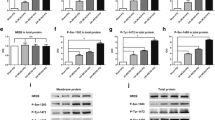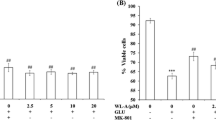Abstract
Our previous studies have demonstrated that ginsenoside Rd (GSRd), one of the principal ingredients of Pana notoginseng, has neuroprotective effects against ischemic stroke. However, the possible mechanism(s) underlying the neuroprotection of GSRd is/are still largely unknown. In this study, we treated glutamate-injured cultured rat hippocampal neurons with different concentrations of GSRd, and then examined the changes in neuronal apoptosis and intracellular free Ca2+ concentration. Our MTT assay showed that GSRd significantly increased the survival of neurons injured by glutamate in a dose-dependent manner. Consistently, TUNEL and Caspase-3 staining showed that GSRd attenuated glutamate-induced cell death. Furthermore, calcium imaging assay revealed that GSRd significantly attenuated the glutamate-induced increase of intracellular free Ca2+ and also inhibited NMDA-triggered Ca2+ influx. Thus, the present study demonstrates that GSRd protects the cultured hippocampal neurons against glutamate-induced excitotoxicity, and that this neuroprotective effect may result from the inhibitory effects of GSRd on Ca2+ influx.





Similar content being viewed by others
References
Ankarcrona M, Dypbukt JM, Bonfoco E, Zhivotovsky B, Orrenius S, Lipton SA, Nicotera P (1995) Glutamate-induced neuronal death: a succession of necrosis or apoptosis depending on mitochondrial function. Neuron 15:961–973
Cai BX, Li XY, Chen JH, Tang YB, Wang GL, Zhou JG, Qui QY, Guan YY (2009) Ginsenoside-Rd, a new voltage-independent Ca2+ entry blocker, reverses basilar hypertrophic remodeling in stroke-prone renovascular hypertensive rats. Eur J Pharmacol 606:142–149
Choi DW, Rothman SM (1990) The role of glutamate neurotoxicity in hypoxic-ischemic neuronal death. Annu Rev Neurosci 13:171–182
Denizot F, Lang R (1986) Rapid colorimetric assay for cell growth and survival. Modifications to the tetrazolium dye procedure giving improved sensitivity and reliability. J Immunol Methods 89:271–277
Dingledine R, Borges K, Bowie D, Traynelis SF (1999) The glutamate receptor ion channels. Pharmacol Rev 51:7–61
Dirnagl U, Iadecola C, Moskowitz MA (1999) Pathobiology of ischaemic stroke: an integrated view. Trends Neurosci 22:391–397
Guan YY, Zhou JG, Zhang Z, Wang GL, Cai BX, Hong L, Qiu QY, He H (2006) Ginsenoside-Rd from Panax notoginseng blocks Ca2+ influx through receptor- and store-operated Ca2+ channels in vascular smooth muscle cells. Eur J Pharmacol 548:129–136
Kaech S, Banker G (2006) Culturing hippocampal neurons. Nat Protoc 1:2406–2415
Kalia LV, Kalia SK, Salter MW (2008) NMDA receptors in clinical neurology: excitatory times ahead. Lancet Neurol 7:742–755
Kim YC, Kim SR, Markelonis GJ, Oh TH (1998) Ginsenosides Rb1 and Rg3 protect cultured rat cortical cells from glutamate-induced neurodegeneration. J Neurosci Res 53:426–432
Kim S, Ahn K, Oh TH, Nah SY, Rhim H (2002) Inhibitory effect of ginsenosides on NMDA receptor-mediated signals in rat hippocampal neurons. Biochem Biophys Res Commun 296:247–254
Kim S, Kim T, Ahn K, Park WK, Nah SY, Rhim H (2004) Ginsenoside Rg3 antagonizes NMDA receptors through a glycine modulatory site in rat cultured hippocampal neurons. Biochem Biophys Res Commun 323:416–424
Lee E, Kim S, Chung KC, Choo MK, Kim DH, Nam G, Rhim H (2006) 20(S)-ginsenoside Rh2, a newly identified active ingredient of ginseng, inhibits NMDA receptors in cultured rat hippocampal neurons. Eur J Pharmacol 536:69–77
Li N, Liu B, Dluzen DE, Jin Y (2007) Protective effects of ginsenoside Rg2 against glutamate-induced neurotoxicity in PC12 cells. J Ethnopharmacol 111:458–463
Li XY, Liang J, Tang YB, Zhou JG, Guan YY (2010) Ginsenoside Rd prevents glutamate-induced apoptosis in rat cortical neurons. Clin Exp Pharmacol Physiol 37:199–204
Lian XY, Zhang Z, Stringer JL (2006) Anticonvulsant and neuroprotective effects of ginsenosides in rats. Epilepsy Res 70:244–256
Lipton SA (2006) Paradigm shift in neuroprotection by NMDA receptor blockade: memantine and beyond. Nat Rev Drug Discov 5:160–170
Liu X, Xia J, Wang L, Song Y, Yang J, Yan Y, Ren H, Zhao G (2009) Efficacy and safety of ginsenoside-Rd for acute ischaemic stroke: a randomized, double-blind, placebo-controlled, phase II multicenter trial. Eur J Neurol 16:569–575
Lo EH, Dalkara T, Moskowitz MA (2003) Mechanisms, challenges and opportunities in stroke. Nat Rev Neurosci 4:399–415
Lopez MV, Cuadrado MP, Ruiz-Poveda OM, Del Fresno AM, Accame ME (2007) Neuroprotective effect of individual ginsenosides on astrocytes primary culture. Biochim Biophys Acta 1770:1308–1316
Nah SY, Kim DH, Rhim H (2007) Ginsenosides: are any of them candidates for drugs acting on the central nervous system? CNS Drug Rev 13:381–404
Ohtani K, Mizutani K, Hatono S, Kasai R, Sumino R, Shiota T, Ushijima M, Zhou J, Fuwa T, Tanaka O (1987) Sanchinan-A, a reticuloendothelial system activating arabinogalactan from Sanchi ginseng (roots of Panax notoginseng). Planta Med 53:166–169
Paoletti P, Neyton J (2007) NMDA receptor subunits: function and pharmacology. Curr Opin Pharmacol 7:39–47
Rubart M, Wang E, Dunn KW, Field LJ (2003) Two-photon molecular excitation imaging of Ca2+ transients in Langendorff-perfused mouse hearts. Am J Physiol 284:C1654–C1668
Samways DS, Harkins AB, Egan TM (2009) Native and recombinant ASIC1a receptors conduct negligible Ca2+ entry. Cell Calcium 45:319–325
Szydlowska K, Tymianski M (2010) Calcium, ischemia and excitotoxicity. Cell Calcium 47:122–129
Wang CZ, McEntee E, Wicks S, Wu JA, Yuan CS (2006a) Phytochemical and analytical studies of Panax notoginseng (Burk.) F.H. Chen. J Nat Med 60:97–106
Wang G, Wang L, Xiong ZY, Mao B, Li TQ (2006b) Compound salvia pellet, a traditional Chinese medicine, for the treatment of chronic stable angina pectoris compared with nitrates: a meta-analysis. Med Sci Monit 12:1–7
Xia W, Sun C, Zhao Y, Wu L (2011) Hypolipidemic and antioxidant activities of sanchi (Radix notoginseng) in rats fed with a high fat diet. Phytomedicine 18:516–520
Yang L, Deng Y, Xu S, Zeng X (2007a) In vivo pharmacokinetic and metabolism studies of ginsenoside Rd. J Chromatogr B 854:77–84
Yang Z, Chen A, Sun H, Ye Y, Fang W (2007b) Ginsenoside Rd elicits Th1 and Th2 immune responses to ovalbumin in mice. Vaccine 25:161–169
Ye R, Han J, Kong X, Zhao L, Cao R, Rao Z, Zhao G (2008) Protective effects of ginsenoside Rd on PC12 cells against hydrogen peroxide. Biol Pharm Bull 31:1923–1927
Ye R, Li N, Han J, Kong X, Cao R, Rao Z, Zhao G (2009) Neuroprotective effects of ginsenoside Rd against oxygen–glucose deprivation in cultured hippocampal neurons. Neurosci Res 64:306–310
Ye R, Yang Q, Kong X, Han J, Zhang X, Zhang Y, Li P, Liu J, Shi M, Xiong L, Zhao G (2011a) Ginsenoside Rd attenuates early oxidative damage and sequential inflammatory response after transient focal ischemia in rats. Neurochem Int 58:391–398
Ye R, Zhang X, Kong X, Han J, Yang Q, Zhang Y, Chen Y, Li P, Liu J, Shi M, Xiong L, Zhao G (2011b) Ginsenoside Rd attenuates mitochondrial dysfunction and sequential apoptosis after transient focal ischemia. Neuroscience 178:169–180
Yoshikawa M, Murakami T, Ueno T, Yashiro K, Hirokawa N, Murakami N, Yamahara J, Matsuda H, Saijoh R, Tanaka O (1997) Bioactive saponins and glycosides. VIII. Notoginseng (1): new dammarane-type triterpene oligoglycosides, notoginsenosides-A, -B, -C, and -D, from the dried root of Panax notoginseng (Burk.) F.H. Chen. Chem Pharm Bull 45:1039–1045
Zhao H, Li Q, Zhang Z, Pei X, Wang J, Li Y (2009) Long-term ginsenoside consumption prevents memory loss in aged SAMP8 mice by decreasing oxidative stress and up-regulating the plasticity-related proteins in hippocampus. Brain Res 1256:111–122
Zhou S, Yang Y, Gu X, Ding F (2008) Chitooligosaccharides protect cultured hippocampal neurons against glutamate-induced neurotoxicity. Neurosci Lett 444:270–274
Author information
Authors and Affiliations
Corresponding authors
Additional information
Chen Zhang and Fang Du contributed equally to this study.
Rights and permissions
About this article
Cite this article
Zhang, C., Du, F., Shi, M. et al. Ginsenoside Rd Protects Neurons Against Glutamate-Induced Excitotoxicity by Inhibiting Ca2+ Influx. Cell Mol Neurobiol 32, 121–128 (2012). https://doi.org/10.1007/s10571-011-9742-x
Received:
Accepted:
Published:
Issue Date:
DOI: https://doi.org/10.1007/s10571-011-9742-x




